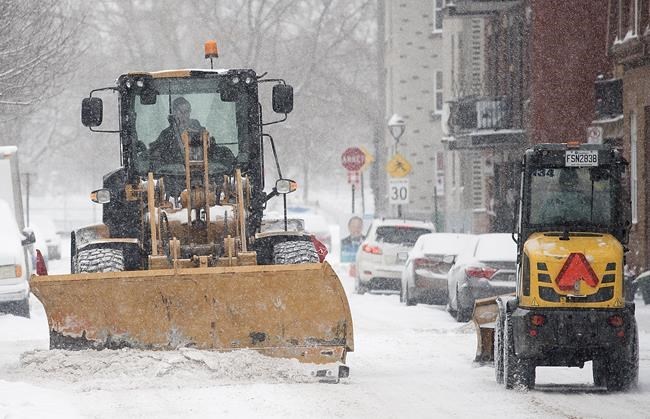MONTREAL — There's a saying in municipal politics: win snow removal, win the day. But as inflation takes a toll on tight city budgets, the price of winning that battle is rising.
Take Montreal, where a combination of high snowfall and dense streets result in the city running one of the biggest snow-clearing operations in the world.
Every year, an army of workers head out to salt, plow and haul away snow from the city's roughly 10,000 kilometres of streets, as well as sidewalks and some bike paths. The upcoming winter season is estimated to cost the city $200 million, according to executive committee member Maja Vodanovic.
Earlier in November Mayor Valérie Plante cited the rising cost of snow removal — of up to 100 per cent year over year in some boroughs — as one of the reasons she had to increase property taxes by an average of 4.9 per cent in 2024. "That's enormous," she said, "but we're not going to stop removing snow."
In an interview, Vodanovic, who is also mayor of the Lachine borough, said the total snow budget this year is estimated at $197 million, about $10 million more than last year. She blamed high inflation, labour shortages, and climate change.
"Many of our contracts are rising, unfortunately, with interest rates and with the shortage of (labour) and especially truckers," many of whom are in their 60s, she said.
The cost of snow-removal trucks have "literally exploded" in recent years, Vodanovic said, because of COVID-19 supply chain disruptions and the war in Ukraine, where many parts were manufactured.
And while some might think climate change-induced milder winters will reduce costs, there are other challenges. Montreal is experiencing more freeze-thaw cycles, forcing it to plow more often to avoid drain blockages and dangerous ice, Vodanovic said.
Heavy snowfall used to be spread out between November to March, but now it's concentrated in January and February. As a result, snow-clearing companies are running all their machines at the same time over a shorter period, hiring more people and requiring them to work overtime.
Other Canadian cities are also seeing their costs rise.
Edmonton says its snow-clearing budget is increasing every year and will hit up to $68.5 million by 2026, a cost the city's general supervisor of infrastructure field operations, Val Dacyk, attributes in part to climate change, including warm temperatures that create slush and flooding.
Winnipeg has budgeted $36.26 million for the 2023 fiscal year — up from $34.70 million in 2022, although the real costs of snow removal have been higher, including $87.18 million in 2022. Mississauga’s winter maintenance budget rose by $1.1 million to $26.82 million for the 2023-24 season.
Even balmy Vancouver has seen its costs steadily rise, from $3.8 million in 2018 to $7.4 million in 2022, during which time the amount of snow the city has received has also increased.
Toronto said its 2024 winter maintenance budget — which is over $100 million per year — is still in development, but will be "higher than 2023" due to "rising costs of equipment, labour and overall market conditions."
No other city in Canada comes close to spending what Montreal does on snow. In addition to being North America's snowiest major city, its downtown is dense, meaning there's little place to put the snow, and it's too cold to let it melt, Vodanovic said.
Those conditions force the city to undertake complex snow-removal operations several times a year, which include towing cars, plowing snow into the middle of the street before loading it onto trucks and driving it to one of more than 20 dumps — an operation that has been estimated in recent years at about a million dollars per centimetre of snow removed.
Jean-Philippe Meloche, an assistant professor in urban planning at Université de Montréal, says snowfall management is a huge challenge for elected officials because of the variable nature of the weather and the anger from citizens if it isn't done right.
"Winter is an obsession for municipal officials," he said.
As well, the snow-clearing market is uncompetitive, Meloche said, which reduces cities' options for contractors and makes the industry vulnerable to collusion — although he added that using private companies remains generally cheaper than using city workers.
Costs are rising because of inflation with machinery and labour, but the quality of snow removal is also going up, he said.
In decades past, the city would dump polluted snow in the rivers that surround the Montreal Island, rather than take it to snow dumps, Meloche explained. As well, Montreal and other Canadian cities used to expect residents to stay home when the weather was bad — or to scramble over snowbanks as best they could.
"Today we know if there's a storm, people are going to go out anyway, and we don't want people to get hurt," he said, not least because people can — and do — claim damages from the city after injuries on icy sidewalks.
Vodanovic agrees. Originally from Croatia, she said she remembers how impressed she was the first time she saw snow and the city's response to it.
"It's like an army out there that clears the snow and makes the city livable in winter," she said. "And I think it's just an amazing feat and I think we don't recognize it enough."
This report by The Canadian Press was first published Nov. 27, 2023.
Morgan Lowrie, The Canadian Press




